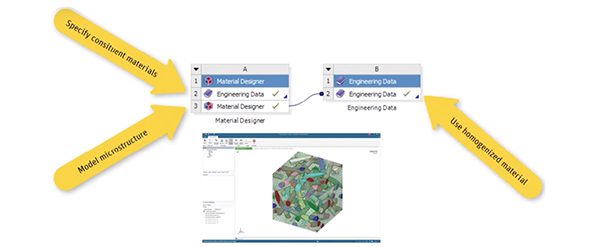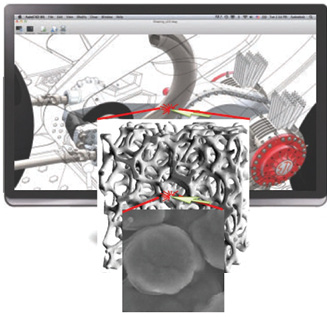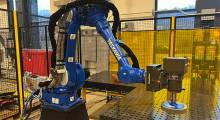The current capabilities of additive manufacturing (AM) are the result of 30 years of invention and innovation. Yet there is so much about the technology that remains a promise. Currently most 3D printers used for AM can use only one material; a select few can print a product with two materials.
The long-term vision for AM materials research is to have CAD-like tools engineers will use to model materials at any scale. Once designed, the 3D printers will blend and process multiple raw ingredients in real time. Such designer materials, engineered as part of the product development process, would spur its own form of industry innovation.
It is a great vision, still very much at the research stage. To understand the challenges and goals, Digital Engineering talked with researchers in academia and industry working to turn the vision of AM designer materials into reality. The general consensus: It is a long path from defining the science to delivering the technology.

“The manufacturing of custom materials for additive manufacturing offers unprecedented flexibility, but they won’t be the exact materials we know today,” says Anthony Dawson, the senior director of product operations for the Materials Business unit at ANSYS. Dawson and others call this new field Integrated Computational Materials Engineering (ICME). “It is a hot topic. It requires understanding how materials behave in processes at multiple scales.”
In the past, Dawson says, “aluminum was aluminum, but now we are generating new materials. We need deeper understanding. How do they behave at different scales?”
As one of the largest simulation vendors, for ANSYS, its mission is to provide full simulation and analysis of new materials and new use cases. “A simple composite material behaves differently on the small scale than at the large scale. We have to homogenize the simulations, [and] tug on it a hundred different ways. We can only imagine the amount of data required.”
Earlier this year, ANSYS acquired Granta Design for its materials expertise. A new ANSYS product from this acquisition is Material Designer, a tool to aid the new material design and creation. At the micro level it can homogenize material properties, analyzing for elastic stiffness, thermal expansion and conduction. The data is then transferred to another simulation at the part or assembly level. A short, detailed introductory video about Material Designer is here.
Seeking New Software
The Georgia Institute of Technology been studying the idea of designer materials for AM for several years, says Yan Wang, an associate professor of mechanical engineering. The idea of local modification of materials or structure, with both polymer and metal, “is needed,” says Wang, “but as of yet there is no such tool.”

Biovia Materials Studio from Dassault Systèmes is the state of the art for commercial products, says Wang, but it is a research tool to predict and understand the relationships of a single material’s atomic and molecular structure with its properties and behavior. It can help engineer a new material, but “this is the starting point” for taking the vision all the way to 3D printing custom materials assembled on the fly.
Wang envisions a CAD-like tool that allows the engineer, for example, to “zoom in on a door knob and spec ‘this much elasticity’ and arrange the composition and gradients of the polymer, put in ingredients and optimize the properties. We need a method to view designs at the crystal level,” in the case of metals, and a way to design for a gradient continuum. The goal becomes a software tool that can tell the 3D printer how to mix rubber and metal in a hose part, for example, with a gradual change from “100% rubber to 1% rubber with 99% copper.”
The properties of some popular materials complicate this line of research even further. “So many times, the properties are not controllable or predictable,” notes Wang. Nickel titanium, for example, has different properties at different ratios. An area of current research is to predict final grain structure for AM processes.
Stability as a Core Value
The material chemistry in an AM process can change depending on whether it is a one-off print or a long production run, says Edwin Hortelano, vice president of materials R&D at 3D Systems. “Stability is the most important factor.” For 3D Systems’ new Figure 4 production AM platform, for example, Hortelano says the company gained considerable experience “learning how to exploit the properties of the system” with new materials that would remain stable when used for lengthy production runs of thousands of parts and then continue to exhibit stability as a finished part.
Looking ahead to designer materials, one research challenge at 3D Systems is how to tailor properties of a material based on where it is in the product. The company currently sells 3D printers using MultiJet Printing technology (MJP), which offer the ability to print with two materials. “MJP can blend for elastomeric and rigid to hit a spectrum of properties,” says Hortelano. “It is a first step in what it can become.”
3D Systems is looking ahead to new printer technology capable of blending metal or polymer powders in a sintering process, changing the mix as needed during the print process. “The principles have been proven of using localized powder blending to get more sintered project properties,” Hortelano says.
Hortelano confesses that as a Ph.D. chemist, he is “not a CAD guy.” Nonetheless, he sees the challenges ahead as easier for the software developers than for the materials and printing process researchers. “To fill the need [for designer AM] with the right value proposition is going to be challenging. It must address the total productivity cost.”
Designing for Random Effects
Carolyn Conner Seepersad has been studying the issues surrounding designer materials for additive manufacturing for 14 years. Currently a professor and General Dynamics faculty fellow at the University of Texas, Austin, Seepersad wrote her doctoral dissertation on how the design of materials within a structure influences material properties. “You have to design for the process, account for the random defects and more to make better, more robust parts” she says.
Internal lattice structures are a hot topic in CAD R&D, with several competing products looking to help engineers add strength, lightweighting and other properties to parts created in 3D printing. Seepersad is studying how material architecture affects parts. She says it will be possible to improve loss factor “by multiples by arranging materials in clever ways.” She is working with scientists at Sandia National Laboratory on a process that uses honeycomb internal structures to create “nearly ideal shock isolators.” Such a material would be “great for isolating sensitive equipment, like high-tech bubble wrap for heavier impacts” and it would be custom for each application.
Companies are reluctant to use lattice and honeycomb internal structure in critical applications, Seepersad says, because “when they are needed most, they are destroyed. They often rely on interesting arrangements that are hard to test.”
The ability to create such insulating materials does not yet exist commercially, and it is “not even streamlined in research, just isolated cases,” says Seepersad. “A full microstructure analysis is still a frontier.” Seepersad mentions current work at Creaform in using optical tools for quality control in additive manufacturing as a step in the right direction.
“How will engineers manipulate these designs and turn them into products? Right now we can make things easier than we can analyze them. It is even harder to render them,” says Seepersad. “We must suppose the arrangement is repeatable, but that’s not always true, which makes analysis break down. Our models are somewhat gross approximations of how they will behave.”
Article topics
Email Sign Up
















